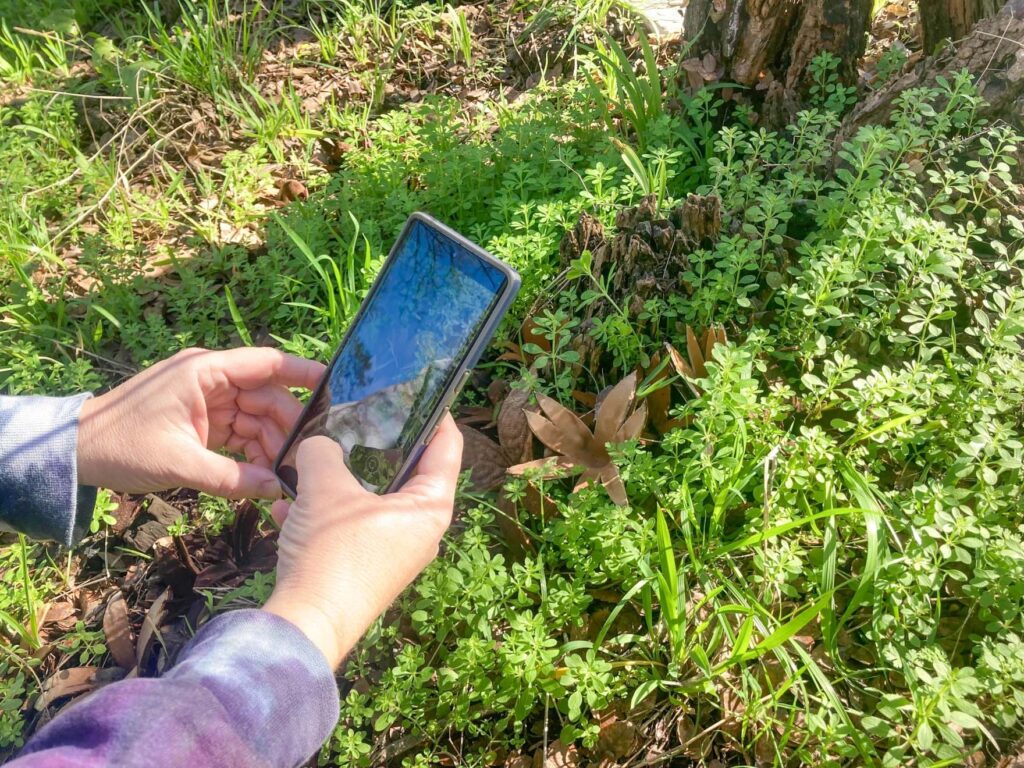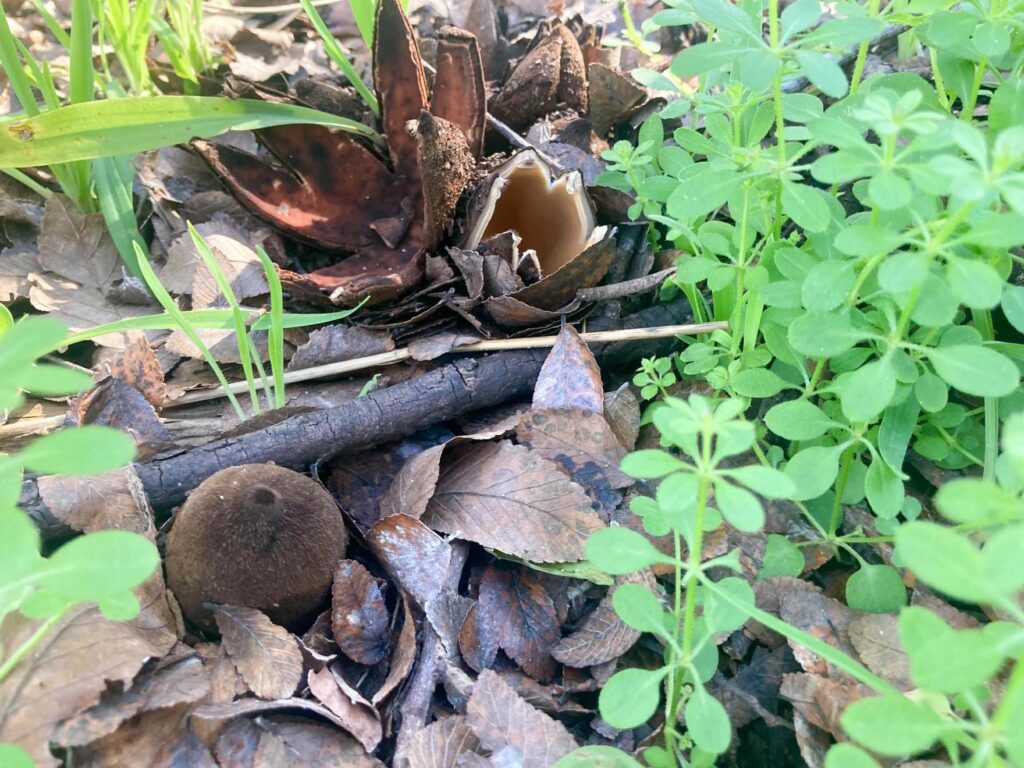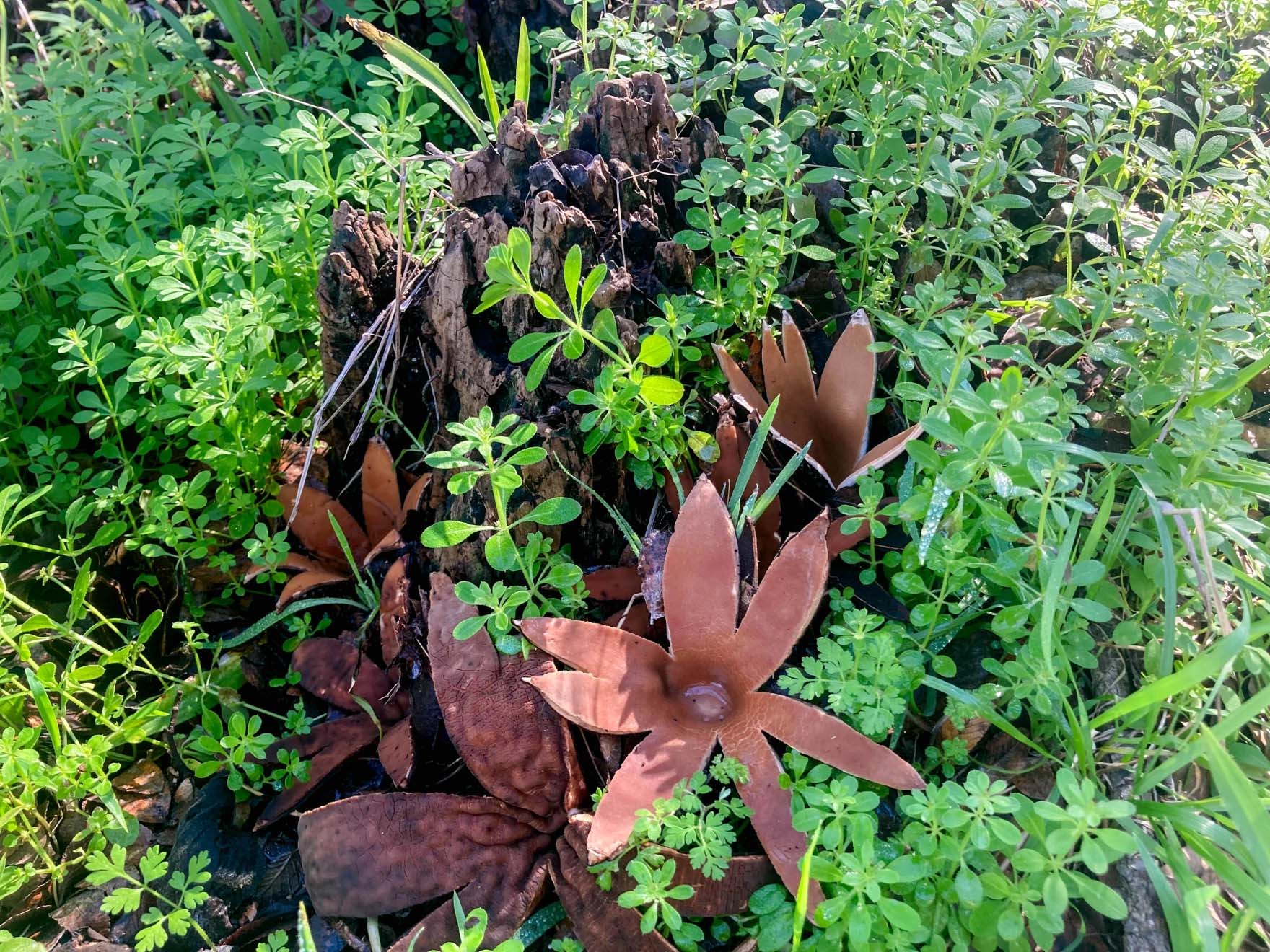From KUT:
Nestled in and around the decaying stump of a Cedar Elm tree at the Zilker Botanical Garden is an unusual sight: butterscotch-colored, leathery stars bursting forth from a blanket of dead leaves.
Angel Schatz carefully approaches the whimsically shaped fungi to get a closer look.
“Wow! Look at this one!” she says. “We have a seven-pointed star here, which is really typical and it’s just looking gorgeous today. Some really large stars.”
Schatz is one of the organizers of the Central Texas Mycological Society, a nonprofit that educates the public about fungi and their critical role in the environment. This winter is proving to be an exciting time for the group because Texas star mushrooms are popping up in and around the Austin area.

Angel Schatz with the Central Texas Mycological Society takes a photo of Texas star mushrooms in the Zilker Botanical Garden on Thursday.
Becky Fogel / KUT
Never heard of them? Well, it turns out Texas stars are the official State Mushroom of Texas. The Legislature passed a resolution in 2021 giving it the official designation.
“We’re the third state to get a state mushroom. Minnesota and Oregon also have a state mushroom. And just [last] year, California and Utah also passed state mushrooms,” Schatz says. “We hope every state eventually gets their own mushroom to recognize.”
While the resolution noted the mushroom has a “starlike shape that makes it seem custom designed for the Lone Star landscape,” it also earned state recognition because Texas is one of the only places it has been found. A botanist first collected specimens in Austin in 1893.
The fungus has also been identified in Japan, Oklahoma and potentially Taiwan.
How did this fungus end up in Texas and Japan?
How the Texas star — known by its Latin name as Chorioactis geaster — ended up in such disparate locations is a mystery, says David Hibbett, a biology professor at Clark University who’s been studying fungi for decades. He says researchers at Harvard found the common ancestor between the mushroom in Japan and Texas was 19 million years old.
“One thing that tells you is that it rules out human-mediated dispersal,” Hibbett says. “Because we know that humans move organisms all over the planet intentionally and otherwise, sometimes with drastic consequences.”
So how the mushroom ended up in both Texas and Japan is an open question.
“Did this thing disperse via spores across the Pacific Ocean? Could it once have existed prior to the breakup of the continents that make up the northern hemisphere?” he says. “We really don’t know.”
Hibbett suggests that if the mushrooms in Texas and Japan were studied in-depth, it would likely turn out that they’re now different species.
“But morphologically, in terms of their physical form, they’re quite similar so they’re hard to tell apart but there are some subtle differences,” he says.
Hibbett says the Texas star is not like a mushroom you’d typically find in the grocery store. It’s more closely related to yeast and lichen, he says, than it is to a button mushroom.
“But for my money it’s still definitely a mushroom. It’s a macroscopic fruiting body of a fungus,” he says. “Its sole purpose is to release spores.”
And oh how it releases spores! The Texas star mushroom actually has another nickname: the Devil’s Cigar.
“This is the Devil’s Cigar because before it opens up into that beautiful star-shaped fruiting body, when it’s still closed it’s kind of cylindrical and it’s dark and I guess it kind of looks like a short, fat cigar or something,” Hibbett says.

Texas star mushrooms are also known by another nickname: the Devil’s Cigar. Before they split into a star shape, they emerge as a stubby brown cylinder.
Becky Fogel / KUT
When the cigar-like fungus splits into a star and releases spores, it makes a hissing sound. Schatz has heard that hiss firsthand and says it’s a pretty rare trait among fungi.
“There’s only 15 mushrooms, to date, that we know of that have an audible hiss to the human ear,” she says. “It’s another reason we call it the Devil’s Cigar, because it’s sending off this smoky amount of spores, making a hiss, and that’s just fun folklore.”
How do you find Texas stars?
Schatz says to find the mushrooms, the first thing you want to do is look for tree stumps — but not any stumps. Cedar Elm stumps.
“They start to turn a blackish color and some mycologists [say], ‘Look for a black crown in the forest.’ So the shape of the stump starts to break down and starts to look like a crown shape, like jagged edges on the top,” she says.
Schatz says it’s important to slow down when you’re out in nature looking for mushrooms. She says you can use a tool like iNaturalist that other mushroom enthusiasts have used to mark where they’ve seen the Texas stars.
The Central Texas Mycological Society is hosting a series of Texas Star Mushroom Walks. One will be held Jan. 21 at Inks Lake State Park, about 70 miles northwest of Austin. Park staff reported on social media that they had spotted the stars there last month.
Inks Lake State Park Superintendent Barrett Durst has said the appearance of the Texas stars (and resulting media coverage) has sparked a lot of interest.
“We’ve received tons of calls over the last few days even about this star mushroom and where to find it, and do we know where it’s at. Our answer is always, ‘Yes! Come on out and we’ll show you,’” he says. But Durst reminds people to tread lightly while seeking out the Texas stars to avoid damaging their environment.
He has seen a bunch of the mushrooms himself along the Valley Spring Creek Trail. Coincidentally, he says, the Texas star — or Devil’s Cigar — can also be found on the Devil’s Backbone Nature Trail. He says he’s enjoyed seeing people get so excited about the mushroom.
“You see that person’s face light up and super bright and cheery and they just found their treasure,” he says, “and if someone’s treasure is seeing a mushroom — that’s awesome.”













